French Cavalry Swords Pt 1: The Holy Trinity (2x 1822, 1829)
Dec 27, 2016 4:58:12 GMT
Post by Afoo on Dec 27, 2016 4:58:12 GMT
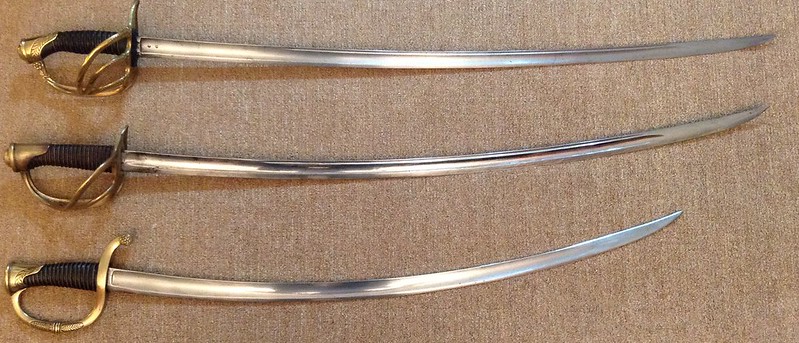
Top to bottom: 1822 Line Cav (Officer). 1822 LC (trooper) 1829 Artillery (Officer). Full res. photo album here
Preamble:
Let me preface this article with a caveat: I know very little about French swords. I have always avoided them in the past because of the premium they command in the antiques market, preferring to spend my money on lesser known, but correspondingly cheaper pieces (hipster out of necessity so to speak). I do known enough to recognize that no article can ever hope to do this topic justice. Thus, this article seeks to share parts of my collection with others on the forums, promote discussion and provide some resources for others considering a similar line of collecting. This is NOT intended to be a comprehensive review of all things French. Part 1 will seek to examine three of the quintessential swords from the first half of the 19th century, while part 2 will focus on some of their derivatives.
My impetus for starting this collection came about when ex-forumite Pino put up an 1822 Bancal for sale. The price was reasonable, and being a fellow Canuck the cheaper domestic shipping and customs (or lack thereof) made the deal too tempting to resist. I was impressed enough to blow my annual sword budget on a pair of its contemporary stable-mates; the 1822 LC and the 1829 Artillery sabre. All three sabres share a common ancestry, but yet evolved to give weapons with very different personalities which makes for an interesting comparison.
A lot has already been said by Uhlan and others concerning the history and development of these three swords, so I will differ to their most excellent posts. As such, I will try to focus more on the subjective aspects of their handling, as well as the more specific details of my examples rather than the history. That said, almost everything I know about these swords comes from the fine posts on SBG, so I would like to give them a general acknowledgement, and give them the proper credit they are due. In particular, I would like to cite Uhlan 's excellent posts on the 1822 LC, 1822 Bancal, 1829 Artillery sword and the 1883/1896 Sword, and Dave Kelly 's review of the Windlass 1840 and 1860 sword - what I have here is but a poor shadow of the work you contribute. Other resources are the article on the 1822 on oldswords, along with this fine blog here.
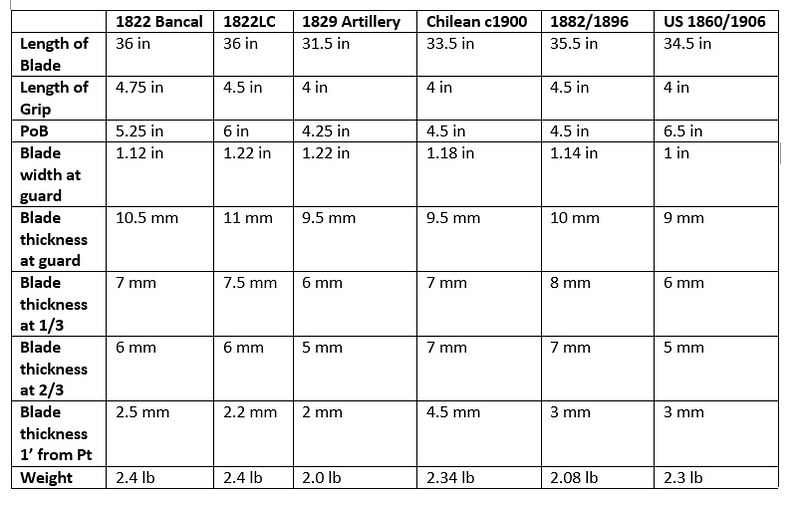
History:
The French 1822 sword grew out of the ANXI sabre (LH) and the 1816 (HC). Both swords were excellent in their own right. However, they were of greatly disparate dispositions, with one having a dramatically curved single-fuller blade, while the other had a dead straight double fullered affair. This rankled some members of the military bureaucracy, which wanted something of a more standardized nature. This gave rise to the 1822 series of swords. While the divide between LC and HC remains (unlike the later British Universal pattern swords), the differences between models was less pronounced. Both now sported similar 2 or 3 bar hilts, and both featured a slightly curved Montmorency style blade. According to Uhlan’s post, the artillery boys were issued a variant of the 1822LC, but it proved too awkward so they switched to a lighter, shorter curved blade in 1829, before going back to the 1822 clunker in 1857

French ANXI (top) and 1816 (bottom) for the light cav and heavy cav respectively. Sourced from the Internet
1822 Bancal:

This here is an Officers version of the 1822 line cavalry (henceforth referred to as the 1822 Bancal to avoid confusion with the 1822 LC or light cav) According to Uhlan, the 1822 troopers was 38.5 inches in length. Officers were required to use the same blade, but were allowed to alter the length of the foible to suit their tastes. As far as I can see, the guard and hilt is pretty reflective of the trooper’s kit as well asides from the added embellishments
Mine was made in 1823 at Klingenthal - the very beginning of the production run. I do not have any solid evidence for its subsequent life, though perhaps someone more knowledgeable than I could interpret the Pincoin markins to get further insight. Interestingly, the scabbard has a single ring. The 1822 LC swords were given a similar alteration in 1887, so I suspect that this particular version was passed down the generations, and was still in service post-1887 to receive such a modification. My particular version sports a 36 inch blade. While its possible it came like that from the factory, I suspect that the blade was shortened around the same time as the scabbard so as better match the dimensions of the current issue 1822 LC’s. Perhaps some of those pincoins represent a government proof mark issued after the blade was altered.
Called the “Bancal” due to its perceived floppiness compared its predecessor, the 1822 is no slouch. The blade starts off at a healthy 10 mm with healthy taper down to 2.5 mm near the tip. The majority of the blade is in the 8-6 mm range, with the foible spanning only the last 6 inches. This is in contrast to the US 1860/1906 for example, where the foible runs for 9 inches on a blade that’s 1.5 inches shorter overall. As such, stiffness along the blade is good, though perhaps not up to the demands of the line cavalry, who ultimately abandoned it in 1854. Also bear in mind that my example is missing 2 inches of foible at the end relative to the full sized troopers, which would further compromise terminal effectiveness. That said, point control is still excellent - much better than the 1822 LC and the 1860 examples which I have available to me. Additionally, the sword very manoeuvrable in the hand and can deliver effective cuts. All in all a good point weapon with just enough compromise to make it an effective cutter in a pinch.
The large 4 bar brass hilt lends mass to the back end and gives the sword a lot of authority in the hand, while giving excellent protection. On my version it also happens to be a work of art, with the earlier floral embellishments. In terms of handling I prefer my US 1906 (more on that later), but as an overall package, the history and sheer beauty of the 1822 Bancal make it one of my favorites.
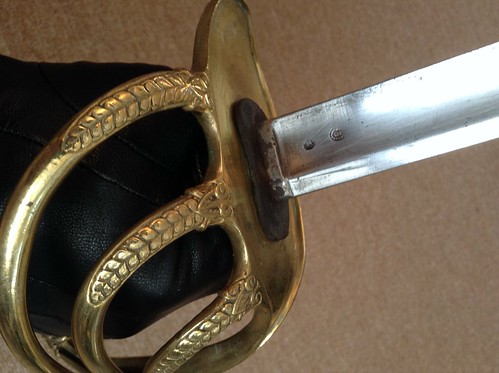
That guard is a thing of beauty! Also, pincoins for us history fans out there - please enlighten us! Original image here
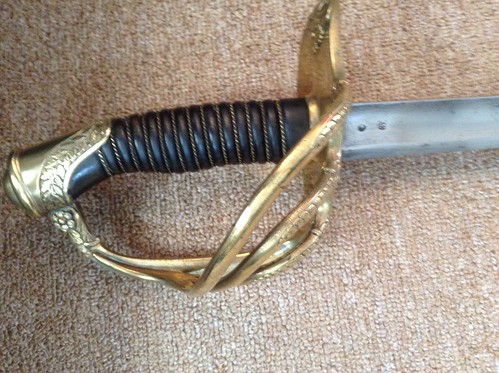
More details of the guard. Also note the slimmer, more refined grip compared to the Trooper's version
1822 LC

This trooper’s 1822 LC is the unkempt mongrel of my French collection. It is also a much later production model, being made in 1877 at Chatellerault. Like the Bancal, this example saw service until at least 1887, after which it was given a single ring scabbard. Allegedly the post-war 1822’s are a bit stodgier than their earlier brethren. Never having held a pre-war model I cannot verify this. However, the shell plate and bars on the guard are much thicker and less refined than on my US 1860/1906, whcih I understand should be very similar in the guard dept. This also holds true for other versions I have seen online, though I could be mistaken. There are also some marks on the base of the blade left over from the mounting process - something that is common on bayonets of the era, but not on swords, at least not on prewar examples.
Apparently this decline also impacted the handling, though my example is still a good sword in its own right. Jordan Williams has a similar vintage model and seems to be perfectly happy as well. Additionally, the taper on my example mirrors what I get on the Bancal, which makes me think that it is still fairly representative of the breed despite being past the best-before date. With this in mind, I would like to bring up my main beef with the 1822 in that its good, but I do not think it justifies the almost legendary reputation it has accrued. Yes, its good – perhaps impressively so given the large dimensions (1.2 x 36) of the blade, but I would not put it above say the Swiss 1867 or the British 1885, both of which offer similar blade dimensions but with similar, if not slightly better dynamic performance. I know there are people who are adamant that the 1822 is the *pinnacle* sword design and everything that came after it was rubbish. This attitude bothers me. The first part of the statement is subjective and may be true for some individuals, fine. However, I doubt the difference between the 1822 and other similar sword patterns is large enough to justify the later. Its like choosing a car. There are *bad* cars to avoid, but when it comes to good cars the playing field is very tight.
As with all designs, the focus on cutting performance requires compromise in the pointy end department. While the 1867 and 1885p which I mention earlier have the same issues, they are not as acute as what we see in the 1822LC As Uhlan mentioned in his post, the 1822 feels kind of “vague”. I actually prefer the US 1906 to the 1822 LC – it sacrifices some cutting ability, but the narrower blade and more acute point lends more confidence in the thrust.
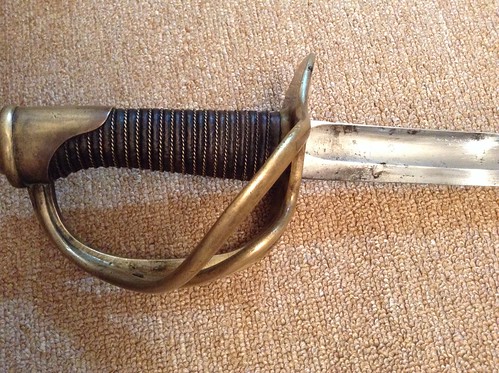
Grip - comes in at a straighter angle than previous examples, though that is not its main issue. Also check out the thickness of those bars!
The other big issue for me is the grip. While the length and shape provides ample room and support for open-handed work, I find that it is a bit too narrow width-wise. This makes it easy to twist in the hand. This is especially an issue with a closed grip, though even with the open grip attention is still required. I am not certain whether this is an issue specific to post-war production examples, or even if it is an issue specific to my hands alone, but figured its something to be mentioned. I recall hearing that the grips were also shortened in the lengthwise direction after the war, but for me this is not an issue.
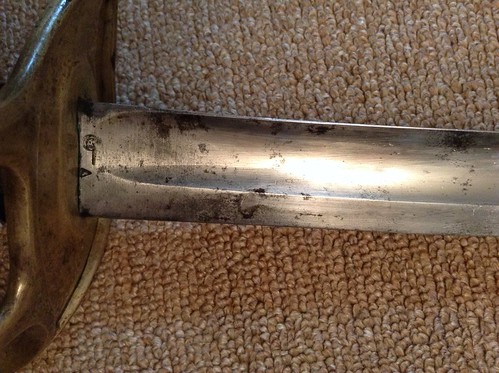
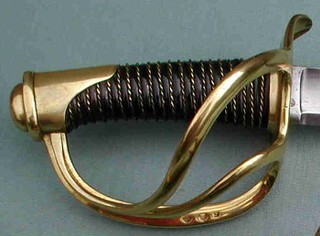 Closeup of the fuller and proof marks. Thats a pretty intense fuller! Also note that in post-1860 production 1822's, the fuller begins in a curve, whereas pre-1860 models have a straight line (see right - image from Internet). The blemish visible at the bottom edge of the fuller is a small dent left from the manufacturing process
Closeup of the fuller and proof marks. Thats a pretty intense fuller! Also note that in post-1860 production 1822's, the fuller begins in a curve, whereas pre-1860 models have a straight line (see right - image from Internet). The blemish visible at the bottom edge of the fuller is a small dent left from the manufacturing process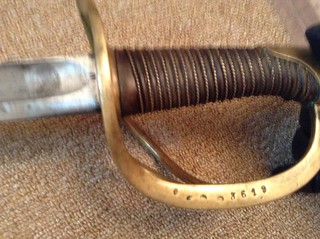
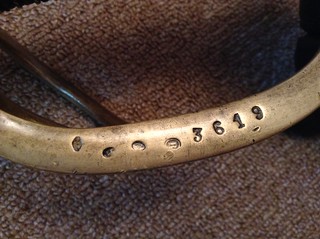
More pincoins - evidence of a long and eventful life? Note how thick the bars of the guard are
1829 Artillery

Lastly, we have the 1829 artillery sword. Made in 1832 at Klingenthal, this sword is a work of art. You can see the workmanship and effort that went into the decorations on the hilt. In part 2 I look at a model 1896 officer sword, and you can see the stark contrast in workmanship on the hilt decorations. This model is unique as it has several cool features. As discussed in Uhlan’s post, the scabbard does not have a throat as per usual. Instead, it has a piece at the top that presses the blade down and secures it in place. There is a recess for the leather washer at the base of the blade, and a peen cap. There was some debate as to when this practice ceased – Uhlan’s 1838 model lacks this feature, suggesting that this practice stopped somewhere between mine (1832) and his.
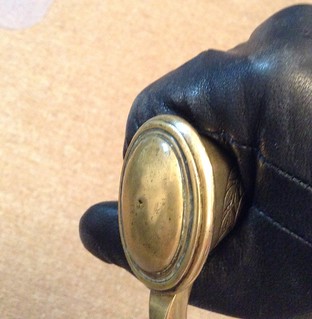
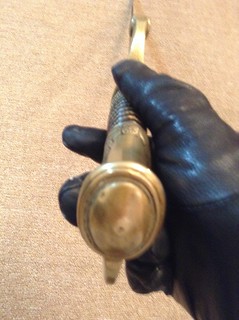
Where's the peen gone! The plain nature of the peen cap relative to Uhlan's suggests an officer who may have been compelled to remove previous decorations - perhaps due to political upheavals - though all this is speculation
The sword itself is the lightest of the three, coming in at just under two pounds. They did not skimp out on blade thickness, but there is a fair amount of profile taper, going from 1.22 inches at the base to 0.87 inches at the start of the foible. By comparison the 1822 only goes to 1 inch. Accordingly, the thing is a joy to handle, though personally I find it a bit too light. To me it lacks a bit of substance and does not inspire confidence. Personally I would rather a Prussian 1873 Blucher – a stout working man’s tool. Granted this is an officer version so one would have to take this with a grain of salt. That said, I believe troopers version featured a similar blade.
The lack of confidence may be more of a personal psychological issue regarding the lightness of the blade relative to my expectations. In terms of thickness the 1829 can dance with the best of them, going from 9.5 mm through to 4 mm at the start of the foible. Stiffness is excellent, but being used the Prussian 1873, the 1829 is a bit disconcerting. Because of this I am not a huge fan. I would almost be disappointed in it if only it did not look so darned good! The extreme curve of the blade and profile taper give it a sense of elegant beauty – bfoo2 likened it to a serpent’s fang – something graceful yet terrifying.
I should also point out the fact that the handles does not really put your hand in line with the point. Not a huge problem if you want to cut, but really does make it harder to take advantage of the drastic profile taper and serpent tooth point.
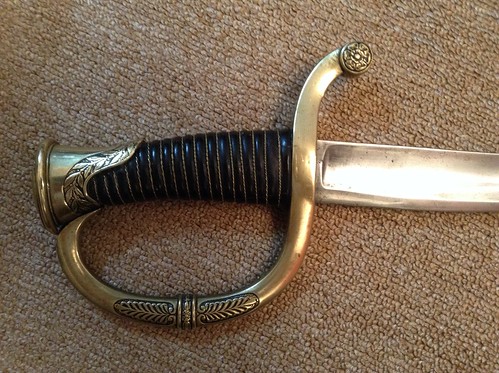
Decorations - trust it to the French to make the simple knuckle-bow look this good
~~~~
While they all have their faults, all three are extremely good swords. The 1822 Bancal is by far my favorite of the three, being a work of art and a tool of war. The 1829 feels a bit too light for me - its sickeningly fast and vicious, but does not lend much confidence in the defence. The 1822L is a solid and trustworthy companion, but perhaps not worth the premium they command. Yes, my 1822 LC is a post-war model, but that was reflected in the price and even then it was pretty dear. Of course, you cannot put a price on personal preference or historical value, but from a purely performance standpoint I feel that there are other models which give better bang for your buck, at least based off of my experience.
Clearly military users do not share my experience, as the 1822 model went on to serve until 1883 in France. Abroad, clones of the 1822's were used by a wide range of countries, from the traditional European powers to Egypt and Persia. The Poles were even buying new production 1822's and using them until the 1920's, which itself is a testament to the merits of the design. While the 1822 died out of general use around 1854, it is still carried by special formations with the French forces to this day, giving it the last laugh of the three presented here
The 1822 line of swords would give rise to a host of related offspring which include the famous US 1840/1860 cav sabres, as well as lesser known derivatives which I have included in the introductory table in anticipation of Part 2
ADDENDUM
One thing I forgot to mention about the 1822's is that they seem to have a slight T-back element to their blade profiles, being that the spine is a touch thicker than the rest of the blade profile would suggest. The difference is not that great (I exaggerate this phenomenon in the image bellow for illustrative purposes),but it could contribute to the good handling characteristics for these models. Its also interesting to note that the 1883 version of the cavalry sword, as well as my Chilean cavalry sword both have more pronounced T-back blade profiles. Perhaps those examples represent a further refinement and development of this design element of the 1822's?




 for me confidence in a sword, whether reproduction or antique is very often a deciding factor. Extremely well done write up, and I agree that the 1822 is a very overhyped sabre, but the countless paintings of the chassuers d'afrique and pictures of the French WW1 Spahis make me happy with my sabre. Also, as someone who, for half of their young life loved to far away from civilization to our to a public school, and worked on horseback quite a lot in my youth, I appreciate the weighted balance the the post war sabres
for me confidence in a sword, whether reproduction or antique is very often a deciding factor. Extremely well done write up, and I agree that the 1822 is a very overhyped sabre, but the countless paintings of the chassuers d'afrique and pictures of the French WW1 Spahis make me happy with my sabre. Also, as someone who, for half of their young life loved to far away from civilization to our to a public school, and worked on horseback quite a lot in my youth, I appreciate the weighted balance the the post war sabres  It certainly inspires a lot of confidence, which I consider to be integral to sword design. It may be my small hands, (glove size small, (US) but I find the grip to be very sturdy in my hand, without twist or looseness. Then again, I really like things with narrow grips, so it may just be personal preference. I think personally the Italian 1860, to me at least inspires the same feel as my 1822. I also had the chance to handle, albeit briefly a German 1811. I loved it, but don't love the price it commands.
It certainly inspires a lot of confidence, which I consider to be integral to sword design. It may be my small hands, (glove size small, (US) but I find the grip to be very sturdy in my hand, without twist or looseness. Then again, I really like things with narrow grips, so it may just be personal preference. I think personally the Italian 1860, to me at least inspires the same feel as my 1822. I also had the chance to handle, albeit briefly a German 1811. I loved it, but don't love the price it commands. 
